The Moon's Location: Understanding Celestial Mechanics
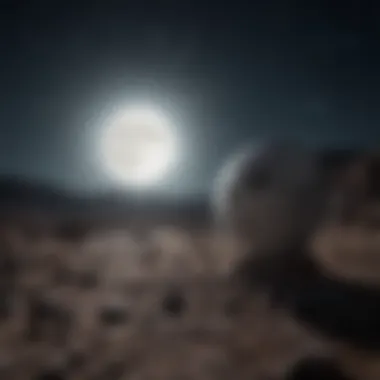
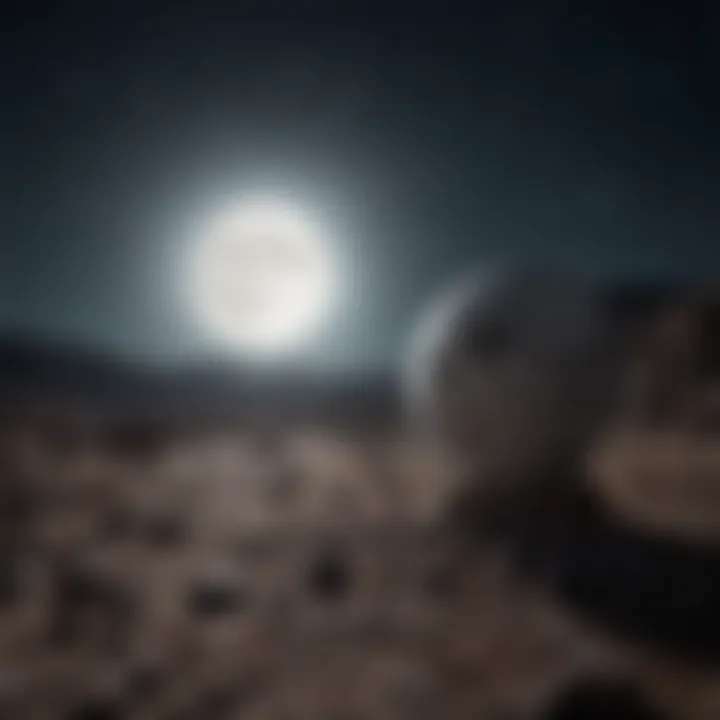
Intro
The Moon holds a central position in humanity's understanding of celestial mechanics, yet it retains an aura of mystery. Its phases, orbit, and gravitational influences render it a topic of great significance in both scientific and observational contexts. Understanding the Moon's location is not a mere academic exercise; it has practical implications on Earth, influencing tides and various biological rhythms. This article outlines the key elements of lunar dynamics, examining phases, orbits, and the technologies that monitor these phenomena.
By delving into gravitational forces, observational techniques, and relevant advancements, readers will gain a complete perspective on the Moon's role in our solar system. This discussion serves to illuminate the intricate interactions between the Moon and Earth, providing a rich foundation for anyone interested in the science underpinning lunar positioning.
Techniques and Tips
Understanding the Moon's location requires both observational techniques and an appreciation for the celestial mechanics involved. Here are essential strategies to enhance your comprehension.
Skill Development
- Observation Skills: Focus on observing the Moon at different times and phases. Document its position against constellations to understand its path across the night sky.
- Data Analysis: Use software like Stellarium to analyze lunar orbits and predict future positions.
Practical Techniques
- Lunar Calendar Utilization: Track the Moon's phases using a lunar calendar. This enables a structured approach to observing its changes.
- Telescope Use: Invest time in mastering telescopes. Observing detailed features on the lunar surface can offer insights into its geographical dynamics.
Common Mistakes to Avoid
- Neglecting Local Conditions: Atmospheric conditions can affect visibility. Be aware of weather and local light pollution.
- Ignoring Historical Context: Understanding historical observations can enhance current readings.
"The Moon not only guides tides; it also commands our curiosity and intellect."
Gear and Equipment
Selecting the right gear is crucial for effective lunar observation. The following items are essential:
Essential Gear for Beginners
- Binoculars: Great for initial observation without the steep learning curve.
- Basic Telescope: A starter telescope helps enhance visibility.
Latest Innovations and Trends
Technological advancements are reshaping how we observe the Moon. Innovations include high-definition telescopes and smartphone adapters that allow detailed photography of lunar features.
Reviews and Comparisons
Consider reading user reviews on platforms like Reddit or specialized astronomy forums to find the best gear tailored to your needs.
Safety Measures
When engaging in nocturnal observations, ensuring safety is critical.
Essential Safety Gear
- Comfortable Clothing: Weather can change rapidly at night; dress appropriately.
- Flashlights with Red Filters: These preserves your night vision while allowing mobility.
Best Practices for Safe Participation
- Buddy System: Always have a partner for safety during nighttime observations.
- Campsite Awareness: Ensure you are aware of your surroundings to prevent accidents.
Injury Prevention and Management
Be aware of the terrain in different observational areas. Simple first-aid kits should be part of your gear for any minor injuries that could occur.
The End
Understanding the Moon's location involves a blend of practical observation skills, the right gear, and safety measures. As advanced technology continues to emerge, the landscape of lunar exploration expands. With a firm grasp of these elements, anyone can take a step closer to unraveling the complexities of the celestial body that has captivated humanity for millennia.
Prologue to the Moon's Location
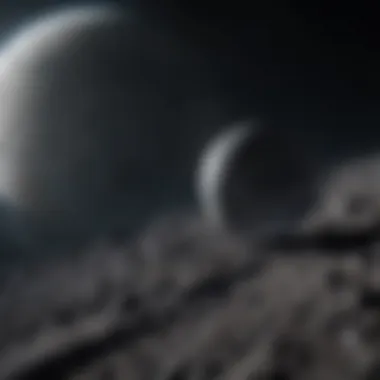
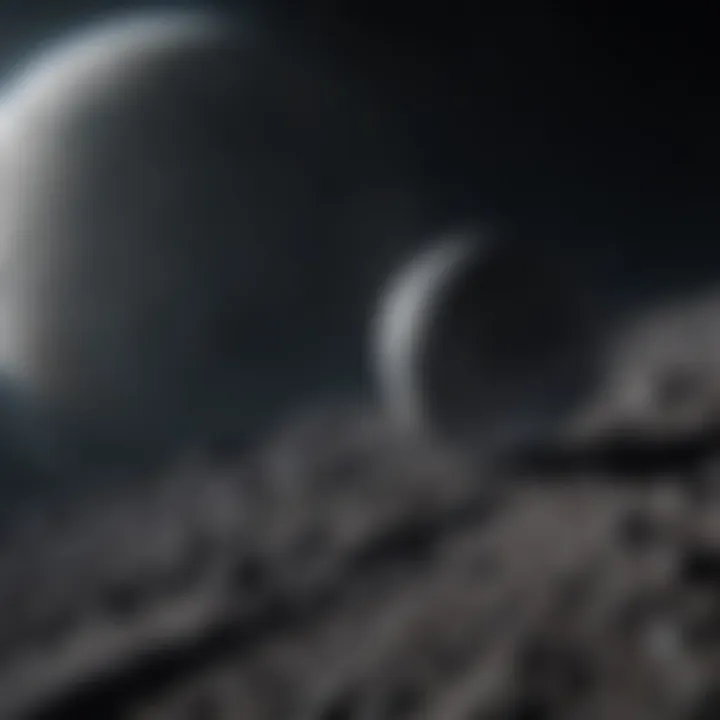
Understanding the Moon's position is fundamental to grasping the intricate dance of celestial bodies. The Moon’s location affects numerous phenomena on Earth, including the tides and various biological cycles. The Moon is not a static entity; it travels through space in a complex orbit around our planet, influenced by the gravitational pull of the Earth and other celestial factors. This section will delve into crucial aspects related to the Moon's placement and its significance, setting the stage for a detailed examination of its orbital mechanics and interactions.
Basic Facts About the Moon
The Moon is Earth’s only natural satellite and has been a subject of fascination for millennia. It has an average distance of about 384,400 kilometers from Earth. The Moon is about one-fourth the size of Earth, with a diameter of approximately 3,474 kilometers. It has a gravitational field that is about one-sixth that of Earth’s.
One must also consider the Moon's surface, which shows numerous craters, mountains, and flat plains known as maria. The absence of atmosphere means these features remain unchanged over long periods. Its lack of atmosphere also leads to extreme temperature variations, making it an inhospitable place for life. Understanding these basic facts provides a contextual framework for the Moon’s influence and dynamics.
The Relevance of Knowing the Moon's Position
Grasping the Moon's position aids in various areas of study and practical applications. In astronomy, knowing where the Moon is at any moment can help predict lunar phases, eclipses, and visual appearances. For marine navigation, the Moon’s gravitational influence plays a crucial role in tidal movements, which directly affects maritime activities.
Moreover, understanding its location has implications in fields such as agriculture and environmental science. For instance, several farmers still plant crops based on the lunar cycle, believing that the Moon's phases can impact crop yields.
In summary, knowing the Moon's position not only enriches our understanding of celestial mechanics but also has tangible impacts across diverse domains. As we continue this exploration, it will be vital to delve deeper into the orbital mechanics and broader implications linked to the Moon's movements.
The Moon's Orbit Around Earth
Understanding the Moon's orbit is crucial in grasping the complexities of its dynamics in relation to Earth. The Moon, as the Earth's only natural satellite, exerts a significant influence on various phenomena, ranging from tides to cultural interpretations of its phases. By appreciating its orbital path, one can better comprehend the astronomical mechanics that govern not only the Moon's movement but also its impact on Earth. This section delves into the underlying principles of orbital mechanics and compares different lunar months, offering insights into the functioning of this celestial body.
Understanding Orbital Mechanics
Orbital mechanics deals with the motions of celestial bodies. In the case of the Moon, its orbit around Earth is an elliptical path. This means that the distance between the Earth and the Moon varies at different points in the orbit. The average distance is approximately 384,400 kilometers (238,855 miles). The Moon's orbit is primarily influenced by the gravitational pull of Earth, which keeps it in a stable trajectory.
The orbital period, which is the time the Moon takes to complete one full cycle around Earth, is essential for several reasons. Firstly, it determines the timing of lunar phases. These phases, including the New Moon, First Quarter, Full Moon, and Last Quarter, arise from the geometric relationship between the Earth, the Moon, and the Sun.
Additionally, the Moon's orbit is inclined about 5 degrees to the plane of the Earth's orbit around the Sun. This tilt has implications for eclipse occurrences and other phenomena. Understanding these mechanics is vital for both scientific study and practical applications like navigation.
Timeframe of Orbit: Sidereal vs. Synodic Month
The Moon's orbit can be examined through two primary timeframes: the sidereal month and the synodic month.
- Sidereal Month: This period lasts about 27.3 days. It is the time taken for the Moon to complete one orbit around Earth relative to the background stars. This measurement is crucial for astronomers as it reflects the actual orbital motion without interference from the Sun.
- Synodic Month: This duration is approximately 29.5 days and represents the time from one New Moon to the next. It is impacted by the Earth’s movement around the Sun. As the Earth travels, the Moon must cover a little extra distance to return to the same phase. This difference is vital in understanding the Lunar calendar and its cultural significance.
Both measurements are essential in various applications, including the prediction of lunar phases, eclipses, and for enthusiasts tracking the Moon's visibility in night skies. Each month gives context to different navigational and observational strategies for those who engage in activities such as night-time photography or astronomical research.
Understanding the differences between sidereal and synodic months is essential for accurate lunar observation and cultural significance worldwide.
Ultimately, these insights into the Moon's orbit provide a foundational understanding for further exploration and study of its effects and relevance to life on Earth.
Lunar Phases and their Implications
The lunar phases present a fascinating aspect of the Moon's location and dynamics. Understanding these phases is crucial for several reasons. First, they define the visual cycle of the Moon as observed from Earth. This cycle plays a role in various natural phenomena, such as tides, and influences cultural practices and beliefs across the globe. Furthermore, knowing the lunar phases can aid in agricultural planning, fishing, and other activities influenced by natural light and gravity. The implications are not just scientific but also cultural, as these phases have inspired art, folklore, and religious beliefs throughout history.
New Moon to Full Moon: A Cycle Explained
The lunar cycle spans approximately 29.5 days, during which the Moon transitions from a New Moon to a Full Moon and back. During the New Moon phase, the Moon is positioned between the Earth and Sun. This results in the illuminated side facing away from our planet, making it nearly invisible. As days progress, the Moon waxes, gradually revealing its crescent shape. This phase culminates in the Full Moon when the Moon is on the opposite side of the Earth from the Sun, fully illuminated. The time between these phases can affect human behaviors and natural trends. Research suggests that factors like sleep, mood, and even crime rates can show variations with the lunar cycle, although conclusive evidence is still debated.
Cultural Interpretations of Lunar Phases
Throughout history, different cultures have interpreted lunar phases in various ways. The New Moon has often been considered a time for reflection and new beginnings, symbolizing a clean slate. It is when many rituals and planting activities are initiated. Conversely, the Full Moon has been linked to heightened emotions and mystical beliefs. Many festivals and celebrations stem from the Full Moon, as it is a time when nocturnal activities flourish due to bright illumination.
Cultural practices also reflect the lunar influence. For example, in many indigenous cultures, the phases of the Moon are integrated into calendars and rituals. Farmers may adjust their planting cycles based on lunar phases, believing certain crops flourish better when planted under specific moonlight.
"The Moon has inspired humanity through the ages, shaping not only our mythos but also practical aspects of life, such as farming and navigation."
This intersection of culture and science reveals a more profound connection with the Moon. As lunar studies evolve, understanding cultural interpretations enriches our grasp of humanity's relationship with the cosmos.
The Influence of Gravitational Forces
Understanding gravitational forces is essential in grasping how the Moon affects Earth and vice versa. The interaction between these two bodies is the backbone of many observable phenomena. The gravitational pull of the Moon is not merely an abstract idea; it causes tangible changes on Earth. This section aims to delve into these interactions, particularly focusing on how they shape our environment and life cycles.
Gravitational Interaction Between Earth and the Moon
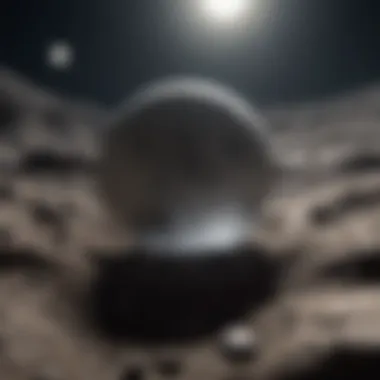
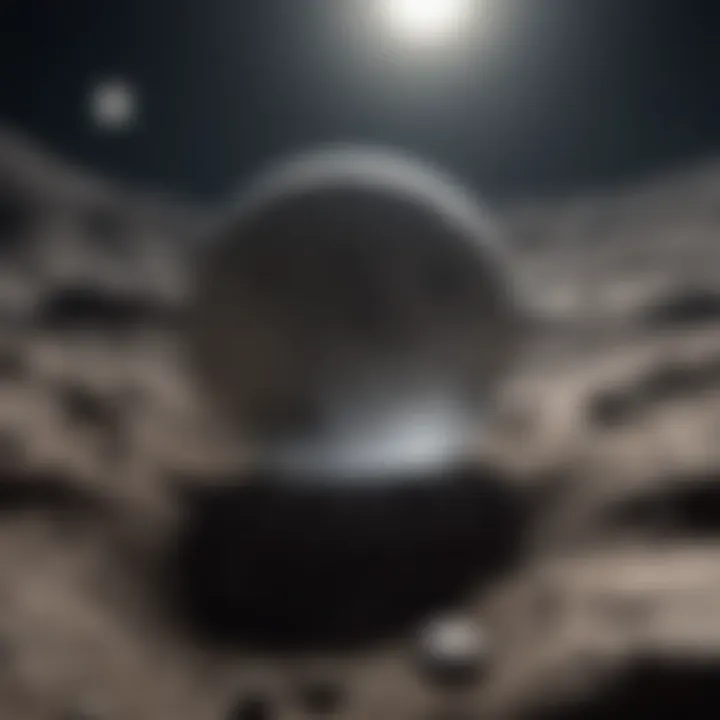
The gravitational relationship between Earth and the Moon is a complex interplay that governs numerous phenomena. The Moon’s gravitational force pulls at Earth, resulting in what we call tides. This effect is not uniform across the planet; instead, it varies according to local geography, water body size, and distance. The strength of the gravitational force diminishes with distance, which is why the Moon's influence is felt differently across various locations.
This relationship has significant implications for Earth’s rotation as well. The gravitational pull of the Moon plays a stabilizing role, moderating Earth’s axial tilt. Such stability is crucial for maintaining a consistent climate over geological timescales. Without this gravitational pull, Earth’s tilt could vary greatly, leading to dramatic climatic shifts that would affect life.
The tug-of-war between the Earth and the Moon creates a delicate balance that is fundamental to life on this planet.
Tidal Forces: Understanding Their Effects
Tides are one of the most visible effects of the gravitational pull exerted by the Moon. They occur in a rhythmic pattern, driven mainly by the Moon's position relative to Earth. During new moons and full moons, when the Earth, Moon, and Sun align, higher high tides and lower low tides occur. This phenomenon is known as spring tides.
On the other hand, when the Moon is at a right angle to the Earth and Sun, we experience neap tides, which are characterized by smaller tidal ranges. Understanding these forces can aid navigation, influence coastal ecosystems, and even impact human activities.
The interplay of tidal forces also extends beyond just water movement. They affect biological cycles, influencing reproduction in various marine species. For example, many fish spawn in correlation with tidal movements, ensuring that their young have a higher chance of survival.
Scientific Tools for Lunar Observation
The observation of the Moon is a scientific endeavor that bridges both ancient wisdom and modern technology. Understanding the Moon's surface, its phases, and its orbital mechanics requires precise instruments and methods. In this section, we will delve into significant tools and innovations that have shaped lunar studies, laying a foundation for deeper exploration and understanding of its location and behavior in space.
Tools for lunar observation serve multiple purposes. They allow scientists and enthusiasts alike to gather critical data and insights. Evaluating the Moon’s surface and its environment requires advancements that can capture images and analyze surface materials. The importance of these tools is compounded by the complexity of celestial mechanics, making them essential not just for amateur astronomers but for professional scientists as well.
Telescopes and Their Role in Lunar Studies
Telescopes have been pivotal in unlocking the Moon's secrets. From Galileo's early contraptions to the sophisticated observatories of today, these devices have transformed our perception of lunar phenomena. Telescopes allow for detailed observation of the Moon's surface features, such as craters, maria, and highlands. They provide a means to evaluate lunar geography and identify changes over time.
There are various types of telescopes used for lunar studies:
- Refracting Telescopes: Use lenses to bend light and form images. They can produce sharp images, making them suitable for lunar observation.
- Reflecting Telescopes: Use mirrors to focus light. These are generally more powerful and can gather light from dim objects, allowing for fainter observations of the Moon.
- Professional Observatories: Advanced telescopes used in space observation. Facilities such as the Lick Observatory and the Mauna Kea Observatories utilize high-powered telescopes to explore the Moon in greater detail.
Despite their benefits, using telescopes comes with challenges. Atmospheric conditions can affect visibility, leading to less-than-ideal observation moments. Moreover, amateur astronomers often face limitations in access to high-quality instruments. However, community observatories provide opportunities to use professional-grade telescopes.
Recent Advances in Lunar Imaging Technology
The recent advancements in imaging technologies have revolutionized lunar studies. High-resolution cameras and digital imaging methods have enhanced the ability to capture the Moon's surface with clarity and precision. Several key developments worth noting include:
- CCD Cameras: Charge-coupled device cameras have become standard in astrophotography. They convert light into electronic signals, capturing high-quality images of faint celestial bodies, including the Moon.
- Adaptive Optics: This technology compensates for atmospheric disturbances, allowing for sharp images despite varying conditions. It is essential for both professional and amateur telescopes to improve lunar observation quality.
- Satellite Imaging: Lunar missions like NASA's Lunar Reconnaissance Orbiter have greatly contributed to our understanding of the Moon's surface. They provide unprecedented detail, mapping its topography and identifying potential resources.
Overall, these technological advancements not only enhance observational accuracy but also open new doors for research. They allow for comparative studies on lunar features over time, contributing to our overall understanding of celestial mechanics.
"Telescopes and modern imaging technologies have changed how we see the Moon, enabling new discoveries and inspiring interest in lunar studies."
By integrating these scientific tools into lunar research, we create a richer tapestry of knowledge that enhances our appreciation of the Moon's role in the cosmos.
Historical Context of Lunar Observation
The study of the Moon has occupied the thoughts of civilizations for millennia. Understanding the historical context of lunar observation provides insight into how early human beings perceived the cosmos and their place within it. This context is essential as it influences contemporary views and practices concerning the Moon. Analyzing ancient observations can reveal the evolution of our understanding of celestial mechanics and its implications for navigation and agriculture.
Early Civilizations and the Moon
In ancient societies, the Moon often held profound significance. Early civilizations such as the Babylonians and Egyptians meticulously tracked lunar cycles. They noted the Moon's regular phases and developed calendars based on its recurring patterns. This knowledge was not merely for keeping time; it was critical for agricultural activities. Farmers relied on lunar cycles to determine the best times for planting and harvesting.
In particular, the Egyptians used the lunar calendar to align their agricultural seasons with the annual flooding of the Nile, which was crucial for their crops. The Moon was also symbolic in many religions, often representing different deities or serving as a key marker in festivals and rituals.
- The Lunisolar calendar is an example of how these civilizations integrated lunar and solar cycles.
- Many cultures, including the Chinese and Indigenous peoples of North America, saw the Moon as central to their mythologies and cosmologies.
The astrological importance of the Moon cannot be overstated. It influenced not only agricultural practices but also societal norms and cultural developments over time. The Moon’s connection to tides and terrestrial phenomena underscored its central role in life on Earth.
Modern Astronomy's Development
As we moved into the 17th century, the understanding of the Moon took significant strides due to advancements in observational technology. The invention of the telescope allowed astronomers like Galileo Galilei to study the Moon's surface more accurately. He published sketches that revealed mountains, valleys, and craters, undermining the ancient notion of a perfect celestial sphere.
In the 18th and 19th centuries, the study of the Moon became more systematic and scientific. Observatories began to emerge, and astronomers meticulously documented the Moon's movements and characteristics. The development of mathematical models increased understanding of its orbital mechanics and phases.
"The Moon is not merely a shining celestial body; it is a key to understanding fundamental aspects of our universe."
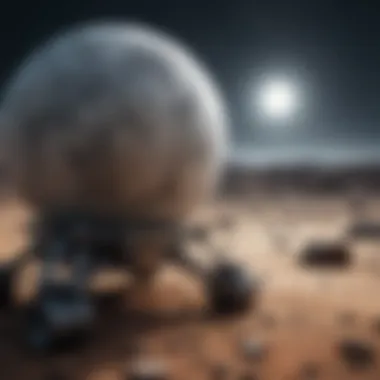
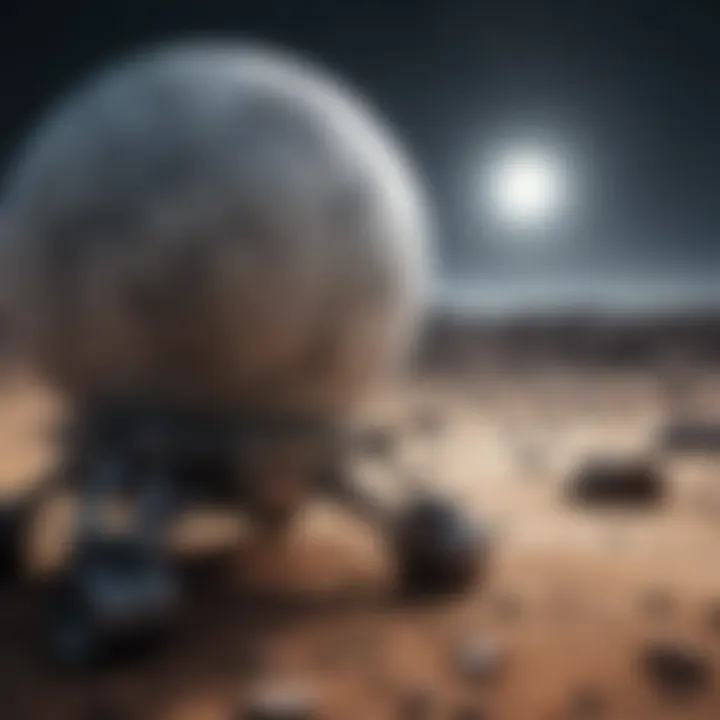
With the advent of space exploration in the mid-20th century, lunar observation took on new dimensions. The Apollo missions provided detailed photographs and samples, fostering a deeper understanding of the Moon's formation and geological history. The insights gained from these missions have had lasting effects on both scientific discourse and the public's imagination.
In summary, the historical context surrounding lunar observation is rich and multifaceted. From the agricultural practices of ancient societies to the scientific advancements of the modern era, our understanding of the Moon continues to evolve. The historical significance of lunar observation reflects humanity’s quest for knowledge, control over nature, and an ongoing curiosity about the universe beyond our planet.
Navigational Uses of the Moon
Understanding the navigational uses of the Moon highlights its crucial role in human exploration and travel. For centuries, mariners and explorers have relied on lunar positions to navigate across oceans and uncharted lands. This section delves into historical practices and modern technologies that utilize the Moon's predictable movements.
Lunar Navigation: Historical Practices
In ancient times, seafarers observed the Moon's location to determine their course at sea. They noted the relationship between the Moon, the stars, and the horizon. These observations helped them establish latitude and longitude, guiding them in their journey. Specific celestial events, such as lunar phases, were marked in navigational charts.
- The New Moon marked a particular aspect of navigation, sometimes indicating the best time for sailing due to calm waters.
- The Full Moon was also significant, often providing increased visibility for night navigation.
- Explorers like James Cook meticulously used lunar sightings to chart new territories, enhancing their precision in mapping unknown regions.
Through these methods, ancient cultures improved their understanding of celestial mechanics, fostering trade and exploration across vast distances.
Current Technologies Leveraging the Moon
In the contemporary context, technologies have evolved to harness the Moon’s position more accurately. Modern navigation employs sophisticated systems which integrate the lunar phases into broader astronomical models.
- GPS satellites incorporate lunar navigation in their algorithms, providing vital alignment data which improve location accuracy.
- Instruments such as lunar range finders utilize the connection between the Earth and Moon to calibrate position data reliably.
- App-based navigation tools provide users with lunar phase information, helping adventurers plan for activities such as stargazing, hiking, or nighttime photography.
These advancements deepen our understanding of the Moon's impact on navigation. They also emphasize the Moon's continuing relevance in modern society, offering tools for safe exploration.
The Moon's influence on navigation is more than historical; it embodies a blend of age-old practices and cutting-edge technologies, bridging our past and future in exploration.
Future Perspectives on Lunar Studies
The future perspectives on lunar studies hold remarkable potential for enhancing our understanding of both the Moon and its influence on Earth. This chapter habitually sheds light on anticipated scientific advancements, novel exploration methods, and collaborative initiatives between nations. It highlights why lunar studies are important, not only for academic research but also for practical applications in technology and society.
The Role of Space Exploration
Space exploration is pivotal in unveiling the Moon's mysteries. Programs like NASA's Artemis aim to return humans to the lunar surface and establish a sustainable presence. This endeavor will push the boundaries of what we know and expand the horizons of lunar research.
Key benefits of space exploration include:
- Technological Advancements: Innovations in robotics, life support systems, and materials science will emerge from lunar missions.
- Scientific Research: Frequent manned and unmanned missions will provide opportunities for geological studies, helping answer fundamental questions about the Moon's formation and evolution.
- International Collaboration: Countries are increasingly working together. The construction of the Lunar Gateway, an orbital outpost, exemplifies global efforts in lunar exploration.
"Space exploration not only broadens our scientific reach, but it also reinforces our unity as earthly beings exploring the cosmos.'
Potential for Lunar Colonization
The concept of lunar colonization has shifted from science fiction to a tangible possibility. As nations and corporations express interest in establishing bases, several factors must be considered.
- Sustainability: Colonization efforts will require sustainable living conditions. Resources, such as water ice found in permanently shadowed craters, may support human life and fuel production.
- Economic Viability: The commercialization of lunar resources could provide incentives for investment. Mining for rare minerals could lead to economic benefits back on Earth.
- Safety and Infrastructure: Understanding the lunar environment is crucial. Planning for radiation protection and building habitable structures are vital steps towards successful colonization.
The next era of lunar studies will not only enhance our comprehension of lunar dynamics but also offer practical implications for humanity. As interest grows and technologies advance, future lunar studies promise to unlock new chapters in our exploration of space.
Epilogue: The Moon's Continuing Significance
The Moon holds a prominent position in our natural and societal frameworks. Its influence extends beyond mere aesthetics of night skies, reaching into the realms of science, culture, and everyday life. Recognizing its significance leads to a deeper appreciation of both our planet and the cosmos. This article illustrates various aspects of the Moon’s position and dynamics, reinforcing its importance in numerous contexts.
Impacts on Earth and Society
The Moon affects Earth in many tangible ways. One of the most well-known impacts is the phenomenon of tides. The gravitational pull of the Moon creates variations in sea levels, which influences ecosystems along coastlines. This tidal action plays a crucial role in marine life, affecting feeding patterns and migration.
Moreover, the Moon has been a key factor in cultural developments. Throughout history, various societies have aligned calendars and rituals with lunar phases. The concept of timekeeping in many cultures has roots in lunar cycles. Festivals and agricultural practices often depend on the Moon's phases, showcasing its influence on human behaviors and societal structures.
Here are some of the Moon's specific impacts on Earth and society:
- Tidal Cycles: The Moon's gravitational pull generates rhythmic tides, influencing marine habitats.
- Cultural Significance: Many cultures honor lunar cycles through traditions, calendars, and rituals.
- Scientific Research: The Moon serves as a focal point for studies in planetary science and astrophysics.
Understanding the Moon's continual influence reveals much about our interconnectedness within the universe.
A Call for Further Exploration
The Moon presents a rich avenue for further exploration. Recent advancements in space technology open new frontiers for lunar research. Missions aimed at establishing a sustained human presence on the Moon can lead to profound discoveries in terms of science and technology. Such endeavors not only serve to deepen our understanding of the Moon but also enhance our knowledge of Earth.
Additionally, exploring the Moon can yield insights into resource utilization. Materials found on the lunar surface could potentially support further space missions, creating a foundation for exploration beyond our planet.







